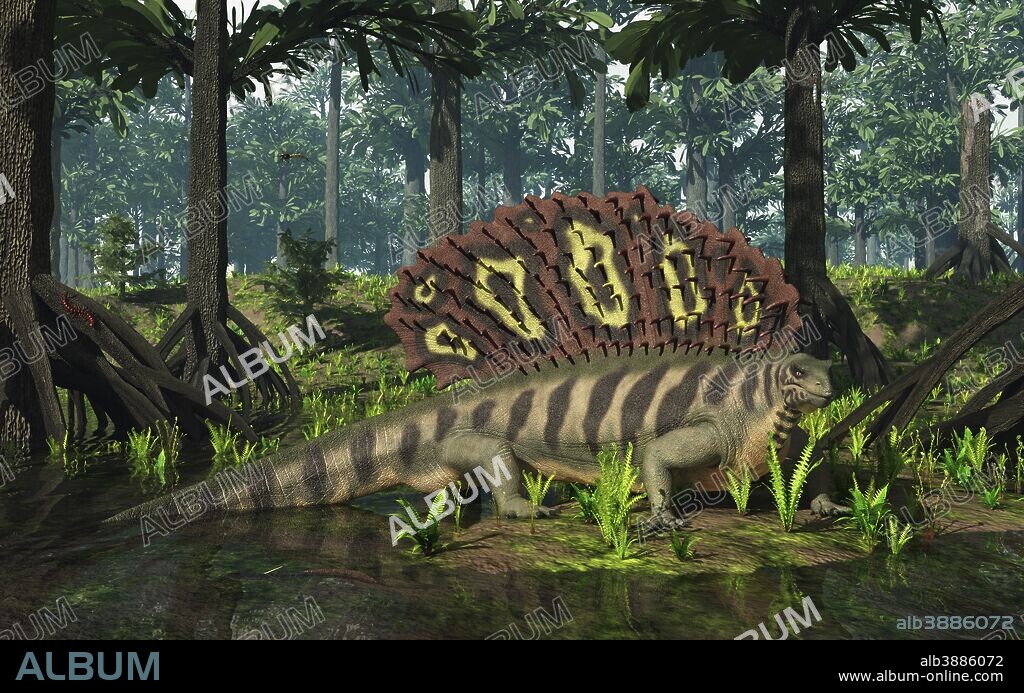alb3886072
An Edaphosaurus forages in a brackish mangrove like swamp.

|
Add to another lightbox |
|
Add to another lightbox |



Title:
An Edaphosaurus forages in a brackish mangrove like swamp.
Caption:
A ten-foot-long, 600 pound synapsid of the genus Edaphosaurus forages in a brackish mangrove-like swamp of gymnosperms of the genus Cordaites 300 million years ago in what is today Western Europe.. . Like its better-known synapsid cousin Dimetrodon, Edaphosaurus had a large sail on its back supported by elongated neural spines, however unlike Dimetrodon, these spines include numerous short cross bars; while the sail may have served the purpose of both helping to regulate body temperature and as sexual display, the purpose of the cross bars is unknown. Jaw and teeth structure suggests that Edaphosaurus probably dined on both plants and small invertebrates, such as mollusks.. . Tree-like Cordaites, now extinct, grew on wet ground similar to the Everglades in Florida, numerous fossils of which are now found associated with coal deposits. Also in this image are several examples of extinct seed fern of the genus Neuropteris as well as smaller examples of generic fern that may have been present during the period.. . Other fauna include two examples of the large dragonfly-like Meganeura, a centipede, and in the foreground a juvenile prehistoric shark of the genus Xenacanthus, its distinctive spine projecting from the back of its head and out of the water.
Credit:
Album / Walter Myers/Stocktrek Images
Releases:
Model: No - Property: No
Rights questions?
Rights questions?
Image size:
5250 x 3281 px | 49.3 MB
Print size:
44.5 x 27.8 cm | 17.5 x 10.9 in (300 dpi)
Keywords:
AMNIOTE • AMPHIBIA • AMPHIBIAN • AMPHIBIOUS • ANIMAL MARKINGS • ANIMAL SCALE • ANIMAL THEMES • ANIMAL • APEX PREDATOR • ARBOL • ARTHROPOD • ARTHROPODA • ARTHROPODS • BACKBONE • BEAST • CARBONIFEROUS PERIOD • CARBONIFEROUS • CARNIVORE • COLOR IMAGE • COLOUR IMAGE • CORDAITES • CREATURE • DAY • DIGITALLY GENERATED IMAGE • DIMETRODON • DINOSAUR • DINOSAURS • EARTH • ECOSYSTEM • EDAPHOSAURID • EDAPHOSAURUS • ENVIRONMENT • ESTUARY • EVOLUTION • EXTINCT • FERN • FIERCE • FLORA • GEOGRAPHY • GEOLOGY • GRAZING • GYMNOSPERM • GZHELIAN • HERBIVORE • HORIZONTAL • ILLUSTRATION • LANDSCAPE • LANDSCAPES • LATERAL VIEW • MARSH • NATURAL HISTORY • NATURAL SCIENCES • NATURE STUDY • NATURE • NEUROPTERIS • NO PEOPLE • OUTDOOR • OUTDOORS • OUTSIDE • PALAEONTOLOGY • PALAEOZOOLOGY • PALEOBOTANY • PALEOGEOGRAPHY • PALEONTOLOGY • PALEOZOIC ERA • PALEOZOOLOGY • PAST • PELYCOSAUR • PENNSYLVANIAN • PHYSICAL GEOGRAPHY • PLANT • PREDATOR • PREHISTORIC ERA • PRIMITIVE • REPTIL • REPTILE • REPTILES • ROAMING • ROOT • SALTMARSH • SCIENCE • SCIENCE: EVOLUTION • SIDE VIEW • SPECIES • SPINE • SWAMP • SYNAPSID • TERRAIN • TOUGHNESS • TREE • TREES • VEGETATION • VERTEBRATE • WILDERNESS • WILDLIFE • WITHOUT PEOPLE • ZOOLOGY
 Pinterest
Pinterest Twitter
Twitter Facebook
Facebook Copy link
Copy link Email
Email

